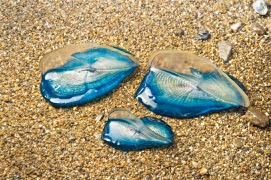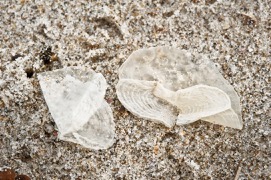Jellyfish, By-the-Wind Sailor
Velella velella
Invertebrate
Cnidaria
Hydrozoa
Porpitidae

Open Water Offshore

Predator

World Wide

Inedible

Hand Sized
The by-the-wind sailor’s body is a flat oval disk 6-7 cm in diameter It has some air-filled bladders that provide buoyancy. Underneath there is a mouth surrounded by and stinging tentacles. On top of the disc there is a stiff flap made of chitin, which acts like a sail. They are bright blue, which may help them blend in to the background and may also protect the animal from the sun.
This colony of animals is common in the open sea, it prefers warmer water but as it is at the mercy of wind and currents, occasionally it will be found in colder waters or even get washed ashore. There may be a difference in preferred sailing direction in the northern and southern hemispheres, and on the eastern and western shores of oceans, but this has been hard to prove.
These animals are predators who use their special stinging cells (nematocysts or cnidae) to feed on plankton. They also have zooxanthellae – symbiotic photosynthetic microalgae that can also provide the animal with food. this can be seen on close inspection as a gold/brown colour in the tissues.
They havspecialised reproductive bodies that produce tiny medusae, little “jellyfish”,
Photo Credit: Rod Morris. Photos can be purchased from https://www.rodmorris.co.nz/

